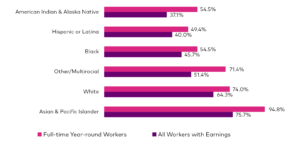This year, August 15th marks Mothers’ Equal Pay Day. This date highlights the inequalities that mothers in the United States face in their pay. Mothers had to work nearly eight more months into 2021 in order to earn the same amount fathers earned in the previous year. In 2021, for all workers with earnings, working mothers only earned 61.7 cents for every dollar a working father made. For those working full-time year-round, working mothers made 73.5 cents compared to fathers.
Regardless of race or ethnicity, mothers earned less than fathers. According to IWPR’s new analysis, Native women earned just barely a third of White, non-Hispanic fathers, making 37.1 percent of fathers. Further, Latina mothers made just 40.0 percent of their male counterparts, while Black mothers earned 45.7 percent of White, non-Hispanic fathers. IWPR research has found that four out of five Black mothers and two out of three Native American mothers are main breadwinners for their families. Not only are the majority of Black and Latina women breadwinners, but they also are estimated to spend twice as much time on care work as men.
FIGURE 1. The Earnings Gap between Mothers and Fathers Widens by Race and Ethnicity
The Median Annual Earnings Ratio for Mothers of the Largest Racial/ Ethnic Groups and White non-Hispanic Fathers

Notes: Mothers and fathers are 16 years and older and defined as having at least one child under the age of 18. Race categories are non-Hispanic; Hispanic or Latinas may be of any race. Fathers are White non-Hispanic. Full-time is at least 35 hours per week; year-round is at least 50 weeks per year. All workers include full-time, part-time, year-round, and part-year workers. Source: IWPR analysis of 2021 CPS-ASEC IPUMS microdata (Integrated Public Use Microdata Series, Version 13.0).
Mothers earned less than fathers in every single state, though differences in pay drastically vary between states. According to IWPR’s new research, for all workers with earnings, mothers had the lowest earnings ratio in Utah, making just 44.9 cents per dollar compared to fathers. On the other hand, Vermont was the state with the highest earnings ratio, with mothers earning 75.8 cents per dollar compared to fathers. Vermont also had the highest earnings ratio for mothers working full-time year-round, making 87.3 cents per dollar. Mothers in Louisiana working full-time year-round made the least out of every state, earning 61.4 cents per dollar, respectively. IWPR research found that mothers with children under the age of 18 report much higher levels of economic insecurity.
Notes: Mothers and fathers are ages 16 years and older and are defined as having at least one child under the age of 18. All workers with earnings include full-time, part-time, year-round, part-year workers. Full-time is at least 35 hours per week; year-round is at least 50 weeks per year.
Source: IWPR analysis of 2017-2021 American Community Survey microdata (Integrated Public Use Microdata Series, Version 13.0)
In addition to paid work, working mothers face extra responsibilities because they take on the majority of unpaid household work and childcare duties. In fact, IWPR research found that, on an average day, women spend an additional two hours (thirty-seven percent more) on unpaid household and care work than men in the United States. This gender gap in unpaid household and care work is only exacerbated for working mothers, particularly because of the poor parental and family leave policies and lack of accessible and affordable childcare. Access to publicly funded pre-kindergarten classes, for example, varies widely between states; universal Pre-K alone would save families $17 billion (about $52 per person in the U.S.) in out-of-pocket child care expenses.
Mothers’ Equal Pay Day emphasizes the inequalities that mothers face in nearly all aspects of their everyday lives—at work and at home. It is imperative for policymakers to expand and guarantee access to paid parental leave policies and increase funding for child care in order to provide equality between mothers and fathers. Policymakers should also strengthen and enforce equal pay laws to eliminate discrimination faced by mothers. Mothers’ work does not stop after the clock, but their wages end even before.

